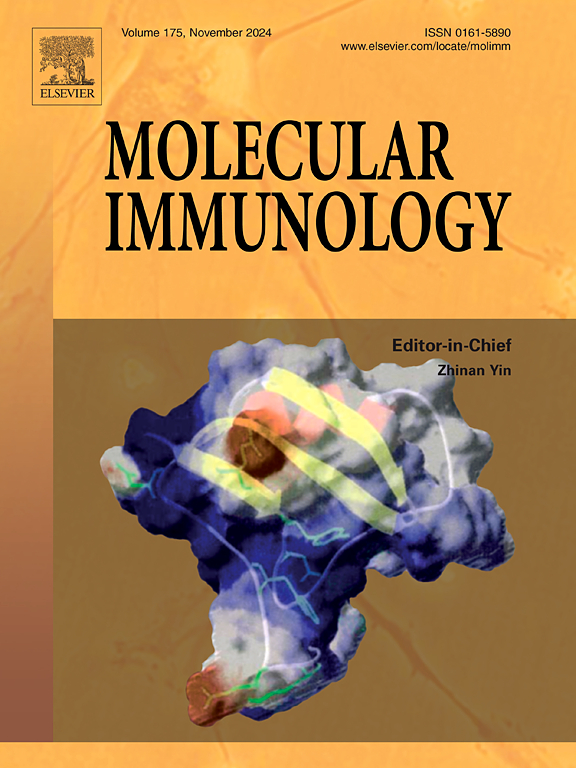IL-33 facilitates endoplasmic reticulum stress and pyroptosis in LPS-stimulated ARDS model in vitro
IF 3.2
3区 医学
Q2 BIOCHEMISTRY & MOLECULAR BIOLOGY
引用次数: 0
Abstract
Background
Inflammatory activation of pulmonary microvascular endothelial cells (PMVECs) initiated by endoplasmic reticulum stress (ERS) contributes to acute respiratory distress syndrome (ARDS). Interleukin 33 (IL-33) has pro-inflammatory and transcriptional regulatory effects. Therefore, this study intends to investigate the effect of IL-33 on ERS and pyroptosis in the hPMVEC.
Methods
The hPMVEC-associated ARDS cell model was induced with lipopolysaccharide (LPS) and treated with 4-PBA (ERS inhibitor), thapsigargin (ERS activator), or IL-33 neutralizing antibody. Western blot and IF staining were performed to analyze the expression of cell-cell junction-associated (Cx37, Cx40, Cx43, Occludin, and Zo-1), ERS-associated (ATF6, IRE1a, and p-Erk), and pyroptosis-associated (NLRP3, IL-1β, and IL-18) proteins. Bioinformatics identified differential expression of IL-33 in ARDS-related datasets and targets of thapsigargin.
Results
IL-33 was highly expressed in serum of ARDS patients and in ARDS cohorts from multiple GEO datasets (GSE237260, GSE216635, GSE89953, GSE263867, and GSE5883), and was significantly correlated with clinical features. 4-PBA decreased permeability and IL-33 levels, and increased Cx37, Cx40 and Cx43 levels in the ARDS cell model. IL-33 neutralizing antibody effectively augmented the levels of Cx43 and Zo-1, and diminished the levels of ATF6, IRE1a, p-Erk, NLRP3, IL-1β, IL-18, ROS, and Ca2 +. The therapeutic effect of IL-33 neutralizing antibodies was reverted by thapsigargin. Moreover, the Swiss Target Prediction and Super-PRED databases obtained 140 and 122 thapsigargin targets, which had 14 intersections. These intersections were associated with immunity, inflammation, apoptosis, pyroptosis, and Ca2+ homeostasis. Notably, CASP8 and PTGS2 interacted with IL-33 in these intersections.
Conclusion
IL-33 promotes ERS and pyroptosis, thereby contributing to barrier damage in ARDS cell models. IL-33 is a promising therapeutic target for ARDS.
IL-33促进体外lps刺激的ARDS模型内质网应激和焦亡。
背景:由内质网应激(ERS)引发的肺微血管内皮细胞(PMVECs)炎症激活是导致急性呼吸窘迫综合征(ARDS)的原因之一。白细胞介素 33(IL-33)具有促炎和转录调节作用。因此,本研究旨在探讨 IL-33 对 hPMVEC 中 ERS 和热蛋白沉积的影响:方法:用脂多糖(LPS)诱导 hPMVEC 相关 ARDS 细胞模型,并用 4-PBA(ERS 抑制剂)、thapsigargin(ERS 激活剂)或 IL-33 中和抗体处理。通过 Western 印迹和 IF 染色分析了细胞-细胞连接相关蛋白(Cx37、Cx40、Cx43、Occludin 和 Zo-1)、ERS 相关蛋白(ATF6、IRE1a 和 p-Erk)和热昏迷相关蛋白(NLRP3、IL-1β 和 IL-18)的表达。生物信息学确定了IL-33在ARDS相关数据集中的差异表达以及硫糖肽的靶标:结果:IL-33在ARDS患者血清中以及多个GEO数据集(GSE237260、GSE216635、GSE89953、GSE263867和GSE5883)中的ARDS队列中高表达,并与临床特征显著相关。在 ARDS 细胞模型中,4-PBA 降低了通透性和 IL-33 水平,提高了 Cx37、Cx40 和 Cx43 水平。IL-33 中和抗体能有效提高 Cx43 和 Zo-1 的水平,降低 ATF6、IRE1a、p-Erk、NLRP3、IL-1β、IL-18、ROS 和 Ca2 + 的水平。硫司加精可逆转 IL-33 中和抗体的治疗效果。此外,瑞士靶点预测数据库和 Super-PRED 数据库分别获得了 140 个和 122 个钠硫磷靶点,其中有 14 个交叉点。这些交叉点与免疫、炎症、细胞凋亡、热凋亡和 Ca2+ 稳态有关。值得注意的是,在这些交叉点中,CASP8和PTGS2与IL-33相互作用:结论:IL-33能促进ERS和热凋亡,从而导致ARDS细胞模型的屏障损伤。IL-33是治疗ARDS的一个很有前景的靶点。
本文章由计算机程序翻译,如有差异,请以英文原文为准。
求助全文
约1分钟内获得全文
求助全文
来源期刊

Molecular immunology
医学-免疫学
CiteScore
6.90
自引率
2.80%
发文量
324
审稿时长
50 days
期刊介绍:
Molecular Immunology publishes original articles, reviews and commentaries on all areas of immunology, with a particular focus on description of cellular, biochemical or genetic mechanisms underlying immunological phenomena. Studies on all model organisms, from invertebrates to humans, are suitable. Examples include, but are not restricted to:
Infection, autoimmunity, transplantation, immunodeficiencies, inflammation and tumor immunology
Mechanisms of induction, regulation and termination of innate and adaptive immunity
Intercellular communication, cooperation and regulation
Intracellular mechanisms of immunity (endocytosis, protein trafficking, pathogen recognition, antigen presentation, etc)
Mechanisms of action of the cells and molecules of the immune system
Structural analysis
Development of the immune system
Comparative immunology and evolution of the immune system
"Omics" studies and bioinformatics
Vaccines, biotechnology and therapeutic manipulation of the immune system (therapeutic antibodies, cytokines, cellular therapies, etc)
Technical developments.
 求助内容:
求助内容: 应助结果提醒方式:
应助结果提醒方式:


